Archived Article Detail
By Thomas P. Moore
WHAT’S NEW IN THE MINERAL WORLD ARCHIVE – posted on 5/23/2008
May 23, 2008
This is a slightly revised/augmented/updated version of the report posted 4 days ago, i.e. on May 19.
Mid-May comes on ominously here in Tucson, with 90°+ F days to foreshadow the imminent five months or so of magmatic temperatures and, what’s more, no big mineral shows in sight for a while. Before I escape for a two-week visit to some old East Coast stomping grounds, here’s some of what has been showing up of late on the web, yes even in this “slow” season.
Post-Dallas Show Words and Pictures
On May 1-4 I went to Dallas, Texas to check out Dave Waisman’s new show there, and found that two dealers had exciting specimens from a new Chinese occurrence of scorodite—adding an entry to the short list of important localities for the beautiful blue-purple iron arsenate. The source of the specimens is said to be a prospect pit near Hezhou, Guangxi Zhuang Autonomous Region, in southern China, where the scorodite crystals apparently come from pyrite pods in a “limonite” gossan; hence they are speckled in most cases with tiny, bright pyrite crystals. Some of the scorodite crystals are darkened to nearly coal-black by inclusions, but “clean” crystals are a most satisfying gemmy blue, and quite sharp, and they reach an impressive 3 cm. In Dallas, some of the Hezhou scorodites were at the hotel show with Marcus Origlieri (www.mineralzone.com), while others were “in preparation” a few miles away, at Rob Lavinsky’s The Arkenstone (www.irocks.com). These two dealers’ best information is that the scorodite specimens do not come from the Pingtouling mine, Guangdong Province (this province borders the Guangxi Zhuang Autonomous Region on the southeast), but rather, as I’ve said, from “Hezhou.” It may be remembered that in 2003 the Pingtouling mine produced stunning yellow-orange mimetite specimens aplenty, and, as reported in this space, a very small number of scorodites were later found there as well. Enter now a (predictable) problem: the website of China Minerals (www.china-mineral.cn), cited many times previously in this space, now features about 25 scorodite specimens which, to judge from their pictures, are from the same very recent discovery, but instead of “Hezhou,” they are said to have come from the Pingtouling mine. The China Minerals specimens are matrixes ranging in size from small-miniature to an impressive 10.5 × 12.5 × 14.5 cm, all with shallow open cavities lined by black or blue scorodite crystals to 1.5 cm individually. These specimens are not as fine, on the whole, as those offered by the two Western dealers, but anyway the general question remains: where does this fine new scorodite come from? Stay tuned for more details on the Dallas specimens when the mailperson brings your July-August issue, and note that Rob Lavinsky has just posted (as of May 22) some of his best Chinese scorodites on the Arkenstonesite.
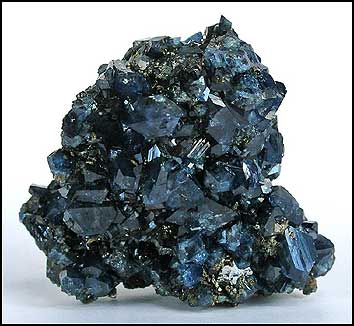
Both specimens 4 cm. iRocks.com photos and specimens.
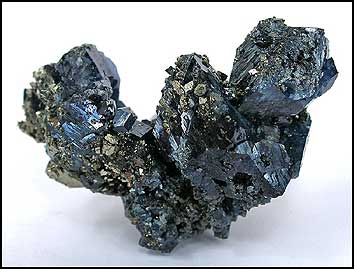
Then there is Emanuele Marini of Demineralia (www.demineralia.com), who has come up with fine specimens from some new discoveries in Madagascar. You’ll read of a couple of these in the Dallas report, but I can’t resist mentioning, ahead of time as it were, a third, since it’s the most intriguing, and since Emanuele has just sent me the nifty picture shown here. Crystals, both loose and in matrix, of the niobium-rich variety of rutile formerly called “strüverite” were described in the 1920’s by French mineralogists from several sites in Madagascar but have not been seen (as far as I know) in good specimens since that time. But Emanuele’s new, blocky to short-prismatic “strüverite” crystals are very sharp, and reach 6 cm. They’re also a dull, opaque brownish black, but some are associated with good red-brown trapezohedral crystals of almandine. The locality is Ialamitana, just south of the town of Antsirabé, in the center of Madagascar.
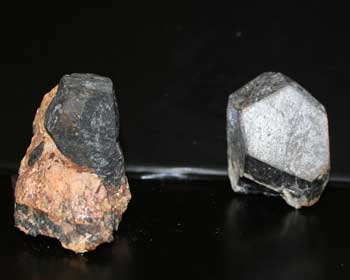
Emanuele Marini specimen and photo.
New on the Web
One of the pleasures of doing “what’s new online” is getting to hear unexpectedly from collectors in remote places, learning of things they’ve been field-collecting, and being enlightened (often enough) by their websites. The other day an e-mail arrived from a chap named Greg Peterson, who lives in British Columbia and has been collecting minerals for seven years and dealing in them for five. Greg’s site, www.geminerals.com, with text both in English and Japanese (!), offers good worldwide (especially Brazilian) specimens, as well as having two special sections devoted to British Columbian quartz localities that Greg is now developing. One, at Harrison Lake, “produces amazing Japan-law twins,” Greg writes, but it is not yet ready for a full introduction, or for the sale of its specimens, on the website. The other locality is a system of Alpine-type clefts “in the shadow of Black Tusk Mountain,” just south of Whistler, British Columbia—and there are specimens of “Black Tusk quartz” currently for sale. The specimens vary considerably in style—from thumbnail-size, Herkimer-like floater singles and doubles to great crystal plates showing individual prisms to several centimeters long. A minority of the quartz crystals are cleanly colorless and transparent, but most show at least some inclusions and/or partial coatings of dark green chlorite, and some crystal groups are entirely blanketed by this shimmering, typically “Alpine,” pocket-filling material. You may read Greg’s article about the find in a small periodical, The BC Rockhounder, put out by the British Columbia Lapidary Society (www.lapidary.bc.ca); also, of course, you may browse or shop your way through the photos of these pretty quartz specimens on the Geminerals site.
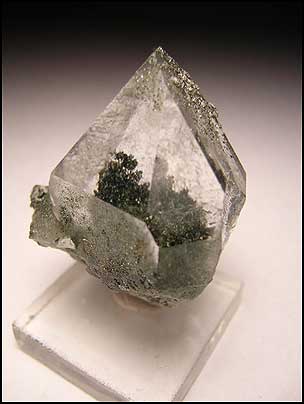
Greg Peterson specimen and photo.
Greg Peterson says that the quartz specimens from Black Tusk Mountain closely resemble those once found in another Canadian Alpine-type occurrence: a roadcut on Route 55 near Windsor, Quebec, where road construction in 1986 exposed the clefts. This brings us to upstate New York’s Mike Walter (mentioned previously in this space), and to the website of his Geologic Desires (www.geologicdesires.com), where quartz specimens from the Windsor occurrence may now be seen. In these specimens, lustrous, colorless, transparent quartz crystals to more than 10 cm long are associated with twinned, milky white to transparent-colorless albite crystals; and, as at Black Tusk Mountain, most of the quartz is tinted green by heavy inclusions, in this case of the rare chlorite-group species chamosite.
The Windsor, Quebec quartz specimens now being offered by Mike Walter once had their homes in the collection of Dr. Steven Chamberlain, a well known, extensively published authority on the minerals of the high-grade metamorphic Grenville Province of southeastern Canada/northern New York. The Chamberlain collection is particularly strong in specimens (many of which he self-collected) from the Grenville Province generally; from St.-Hilaire, Quebec; and from late 20th-century localities in New York and Pennsylvania. From the selection now being offered for sale on the Geologic Desires website, I show here one typically sophisticated item: an aesthetic thumbnail with sharp, translucent green sphalerite crystals on matrix of calcite and dolomite, collected in 1991 by Bryon Brookmyer at the Lincoln quarry, Thomasville, York County, Pennsylvania. This was a one-time pocket occurrence (see pp. 425 and 437 of the September-October 1992 issue), and frankly I’m surprised that the specimen is still available on Mike’s site, where I first saw it back in March—the price of $270 is quite low, I think, for such a distinctive rarity.
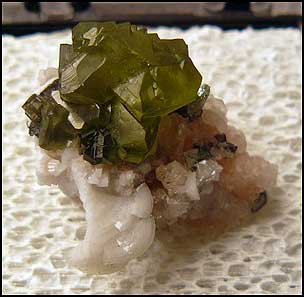
Former Steven Chamberlain collection. Mike Walter specimen and photo.
For reasons not entirely personal and sentimental I’ll dwell a bit more on the topic of minerals from classic localities of the northeastern U.S. Many such specimens may be viewed on a new website, that of Josh Baimel’s Civil Minerals (www.civilminerals.com), which, though it operates out of Florida, is quite strong on classics from the northeast, e.g. Franklin, New Jersey; the Pulsifer quarry, Auburn, Maine; the G.E. Smith quarry, Newport, New Hampshire; and Eden Mills, Vermont. I should say that the site also offers miscellaneous, mostly quite fine, thumbnails of a slightly out-of-the-way persuasion, e.g. carletonite from St.-Hilaire, monazite from Madagascar, manganotantalite from Brazil, stolzite from France, and a doubly terminated, brilliant, loose crocoite crystal from the Red Lead mine, Tasmania. But the heart of the matter at Civil Minerals is the grab-bag of northeastern U.S. specimens, which is major fun to scroll through (can you “scroll through” a “bag?” never mind…); as a pictured example I offer the finest specimen of norbergite which I never managed to dig during numerous trips, long ago, to the Limecrest quarry, Sussex County, New Jersey. (I do have a sharp 5-mm red spinel crystal in white limestone matrix which a friend of mine once collected in this old-time, underappreciated locality.)
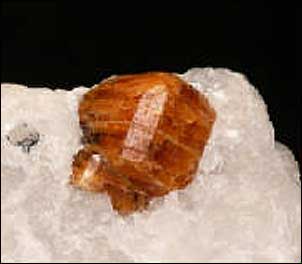
New Jersey. John Baimel specimen and photo.
David K. Joyce (www.davidkjoyceminerals.com) has been noted in this space before for his offerings of Canadian specimens, often little-known and surprising, but this time it’s his selection of top-notch specimens from St.-Hilaire, Quebec which makes the news. Visit this site to see some wonderful miniatures and small cabinet-size specimens of serandite and polylithionite, and some dazzling thumbnails and small miniatures of leifite, leucophanite, eudidymite and epididymite—the picture, here, of David’s thumbnail epididymite says it all.
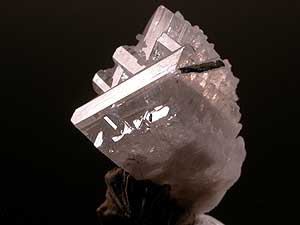
David K. Joyce specimen and photo.
John Veevaert of Trinity Minerals (www.trinityminerals.com) is an old hand at scouring the Tucson Show for specimen lots for his dealership, and in February 2008 he picked up, among other things, some interesting pieces representing a new find of cosalite at the Bolivar (also called the Piedras Verdes) copper-zinc mine near Bahuichivo, Chihuahua, Mexico. Cosalite occurs typically as metallic gray to black, acicular crystals, rarely more than 2 or 3 cm long, with other metallic species on quartz or calcite gangue, and on these Mexican pieces the cosalite crystals form lustrous gray “nests” and tufts to 1 cm in small vugs and crannies in quartz matrix, with crude chalcopyrite crystals. Though not especially photogenic (hence no picture here), these mostly cabinet-size specimens are excellent examples of the rare Pb-Bi sulfosalt.
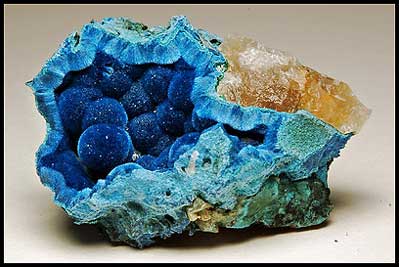
John Veevaert specimen and photo.
The Trinity Minerals website also showcases some specimens of Namibian shattuckite which most certainly are photogenic, and represent discoveries of superbly dramatic specimens of this material over the past two or three years. Baby-blue, finely fibrous crystals of shattuckite form dense cavity-lining coatings with mammillary surfaces in massive yellow-white calcite or massive blue chrysocolla; in some elite specimens brilliant green malachite also appears, as sharp “primary” crystals or acicular sprays. The best and most beautiful specimens show very deep cavities into which one peers, enjoying how the shattuckite surfaces ripple with pale to deep blue chatoyancy. Then again, in other specimens the deep cavities are lined by quartz crystals to a few millimeters individually, and these crystals are lustrous and uniformly bright blue from included shattuckite. John Veevaert’s May 2008 update offers about 20 specimens of shattuckite, shattuckite/malachite, and shattuckite-including quartz; Lehigh Minerals (lehighminerals.com) also has an appealing selection of miniature to cabinet-size pieces. Here again, though, we must face a locality-designation problem (hey, at least no Chinese words are involved this time). Both Lehigh and Trinity place the shattuckite occurrence in the Kaokoland (or Kaokoveld) region of northwestern Namibia, but Trinity gives “Kandesei, Kunene” while Lehigh gives “Okandewasi.” Neither Kandesei nor Okandewasi appears in the index to Ludi von Bezing et al.‘s recent book Namibia: Minerals and Localities, although that excellent work does report significant shattuckite specimens from the Mesopotamie mine and from the Omaue dioptase prospect, both in the Kunene district of Kaokoland. John Veevaert of Trinity relies for his information here on Namibian-minerals expert Ernst A. Schnaitmann of Windhoek, who assures him that the shattuckite specimens indeed come from a place called Kandesei, which is the same place as Okandawasi—its name in the local Herero language. The Omaue dioptase prospect is a different and distinct, though nearby, locality. Schnaitmann also is sure that the commonly seen attribution of shattuckite specimens to “Otjikotu,” Kaokoland, is incorrect, there being no place by that name in Namibia (the closest thing to it is a lake near Tsumeb called “Otjikoto”)—and so, by these lights, we should change “Otjikotu” to “Kandesei” (alternatively, to “Okandawesi”) on our labels. Anyway, there is no problem at all about stating flatly that these shattuckite specimens are the species’ best examples yet found anywhere in the world.
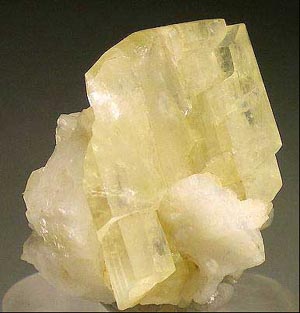
Brazil. John Veevaert specimen and photo.
Now that, four days after I first posted this report, I am so very virtuously revising and updating it, I will mention a couple of attractive new Brazilian things that John Veevaert picked up at the Costa Mesa, California show in mid-May and has just added to his Trinity Minerals site. From Brazilian-minerals impresario Luis Menezes, John procured some very pretty new specimens of montebrasite from the Telirio mine, Linopolis, Minas Gerais (this locality recently has outdone itself in superb specimens of brazilianite). The montebrasite comes as loose, very sharp, part-gemmy, palest yellow to colorless tabular crystals, some single and some butterfly-twinned, to more than 4 cm. Also, from the famous magnesite mines of Brumado, Bahia, Brazil, John now has some lovely small-miniature specimens with sharp, part-gemmy, trigonal crystals of uvite perching lightly on gleaming white clusters of razor-sharp little magnesite rhombohedrons; the uvite is strongly pleochroic, showing, when rotated slowly and lovingly in the light, as alternately green and brown.
In this space last time I mentioned Jordi Fabre’s new specimens of the rare aluminum phosphate senegalite found recently at the species’ type (and only important) locality, the Kouroudiako deposit in the Republic of Senegal, on the westternmost bulge of Africa. And now I’ve heard from French geologist Cédrick Gineste, who runs Pengea Minerals (www.pangeaminerals.com), and who informs me that several more fine new senegalite specimens are available on his site: they were dug by a German collector, though Cédrick himself is the one who “rediscovered” the locality in 2000. Based as he presently is on the French Pacific island of New Caledonia, Cédrick also sells something from there that is rather peculiar, withal quite attractive: lustrous apple-green, botryoidal coatings of “garnierite” on matrix, a few miniature-size specimens of this material having been found very recently in the Thio nickel mine, New Caledonia. Yes you do know, if only vaguely, what I am talking about, from that dreamy browsing in old reference books that you like to do: for instance, my 1949 Dana/Ford Textbook of Mineralogy lists the hydrous Ni-Mg silicate “garnierite” as occurring “in serpentine rock near Noumea, capital of New Caledonia, associated with chromatic iron and steatite, where it is extensively mined.” Well, “garnierite” has been discredited as a species name: Bayliss’s Glossary of Obsolete Mineral Names (2000) equates it to the species pecoraite and népouite, and népouite, according to Fleischer’s Glossary of Mineral Species (2008), is a hydroxide and silicate of Ni and Mg, dimorphous with pecoraite and forming a series with lizardite. But when and where before have you seen any New Caledonian “garnierite” for sale, and have you ever thought that the material could be pretty?
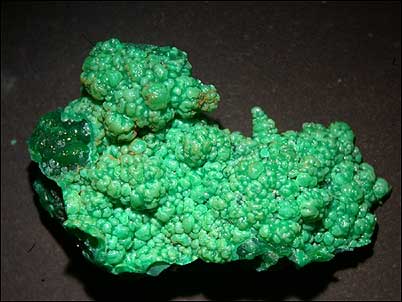
(South Pacific Ocean). Cédrick Gineste specimen and photo.
Last time (in March) I ended by mentioning the ongoing sale of specimens, especially fabulous thumbnail-size specimens, from the Jim and Dawn Minette collection, on Dan Weinrich’s site (www.danweinrich.com); let me end here by repeating the recommendation while adding an update. On May 12 Dan posted 31 more Minette specimens, presenting more of the same in the way of rarity, matchless aesthetics, and general Class. Featured this time are many old English pieces of miniature to cabinet size—who doesn’t love those pellucid calcites and princely blue barites from Cumbria?—but thumbnail priorities are also being served. I suppose I’ll have to provide an example again. All right…here’s the finest thumbnail-size cuprite from the Onganja mine, Namibia, that I have ever seen, priced, reasonably enough, at $750. At September’s Denver Show, courtesy of Dan Weinrich and/or Dave Bunk, we will get our first crack at the Minettes’ significant subcollection of smithsonite…maybe that makes a good little cheer-up thought to wrap around us, like a modest magic heat shield, as we veer into summer.
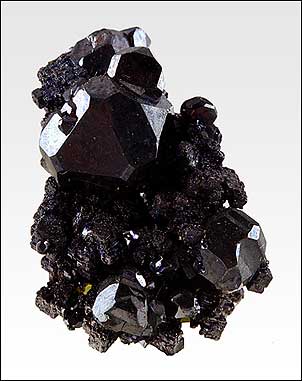
Former Jim & Dawn Minette collection. Dan Weinrich specimen and photo.
For questions about this column, please email Tom Moore.
